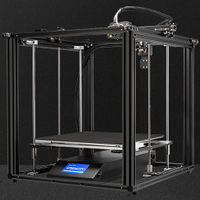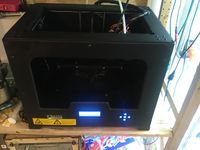3D Printers: Difference between revisions
(Section Re-org.) |
|||
| Line 1: | Line 1: | ||
= Quick Start Instructions = | = Quick Start Instructions = | ||
''These instructions are currently in the process of being re-written and updated.'' | |||
== PrusaSlicer == | == PrusaSlicer == | ||
| Line 7: | Line 9: | ||
== Your First Print == | == Your First Print == | ||
If you are new to 3D printing we ask that you use HackLab's Pusa Mini printers for your first prints, with PrusaSlicer as the slicer. | |||
These are our most reliable printers, and simplest to use. | |||
==== The Toolchain ==== | |||
These instructions will take you from an STL file to a printed object. | |||
An STL describes the idealized 3D object you want to produce. | |||
We won't cover producing the STL file. For the purpose of following this tutorial you can use this STL file, which describes a small storage bin. | |||
''Below here is still being rewritten'' | |||
=== Prusa Mini === | === Prusa Mini === | ||
| Line 23: | Line 36: | ||
''' Please do run 3d printers with being present in the Lab.''' | ''' Please do run 3d printers with being present in the Lab.''' | ||
If a printer fails it could result in cooked filament / extruders, damaged mechanical components, or fires. | If a printer fails it could result in cooked filament / extruders, damaged mechanical components, or fires. | ||
= Explore Further = | = Explore Further = | ||
Revision as of 13:36, 20 February 2024
Quick Start Instructions
These instructions are currently in the process of being re-written and updated.
PrusaSlicer
Hacklab Toronto has consensus around using PrusaSlicer for new users. [Download and Install PrusaSlicer]
Your First Print
If you are new to 3D printing we ask that you use HackLab's Pusa Mini printers for your first prints, with PrusaSlicer as the slicer. These are our most reliable printers, and simplest to use.
The Toolchain
These instructions will take you from an STL file to a printed object. An STL describes the idealized 3D object you want to produce. We won't cover producing the STL file. For the purpose of following this tutorial you can use this STL file, which describes a small storage bin.
Below here is still being rewritten
Prusa Mini
Hacklab's main printers are the Prusa Mini.
Prusa Mini
- Generate Gcode from an STL using PrusaSlicer
- Copy your Gcode to the USB key attached to the printer.
- Click Print
- When finished, allow the bed to cool, and then wipe clean with small amount of isopropyl alcohol on clean paper towel.
DO NOT LEAVE MACHINES UNATTENDED
Please do run 3d printers with being present in the Lab. If a printer fails it could result in cooked filament / extruders, damaged mechanical components, or fires.
Explore Further
Firmware and Configuration
- Wiki doesn't like weird file types so check out our Github
Machines at Hacklab
See individual printer pages for details and maintenance logs.
Physical Problems
- Print not sticking to bed
- Check bed levelness (Prusa's probe this automatically)
- Check print bed distance to print head (Live Z height adjust)
- Extruder no longer extruding filament
- Check filament feeder for ground plastic preventing extrusion
- Check gcode generator settings to ensure proper filament properties selected (diameter, density)
- Inspect hot-end for plugs by manual extrusion at temperature
- Check filament feeder spring pressure (WARNING: DO NOT ADJUST THIS UNLESS YOU KNOW WHAT YOU ARE DOING, THIS IS THE LAST STEP)
- Extrusion is discontinuous
- Check filament feeder for ground plastic preventing full continuous extrusion

